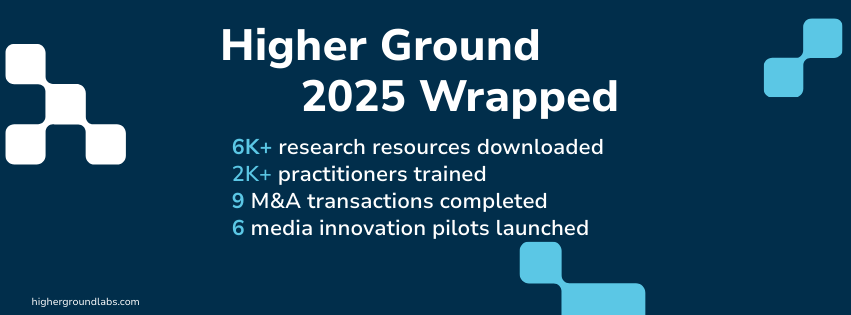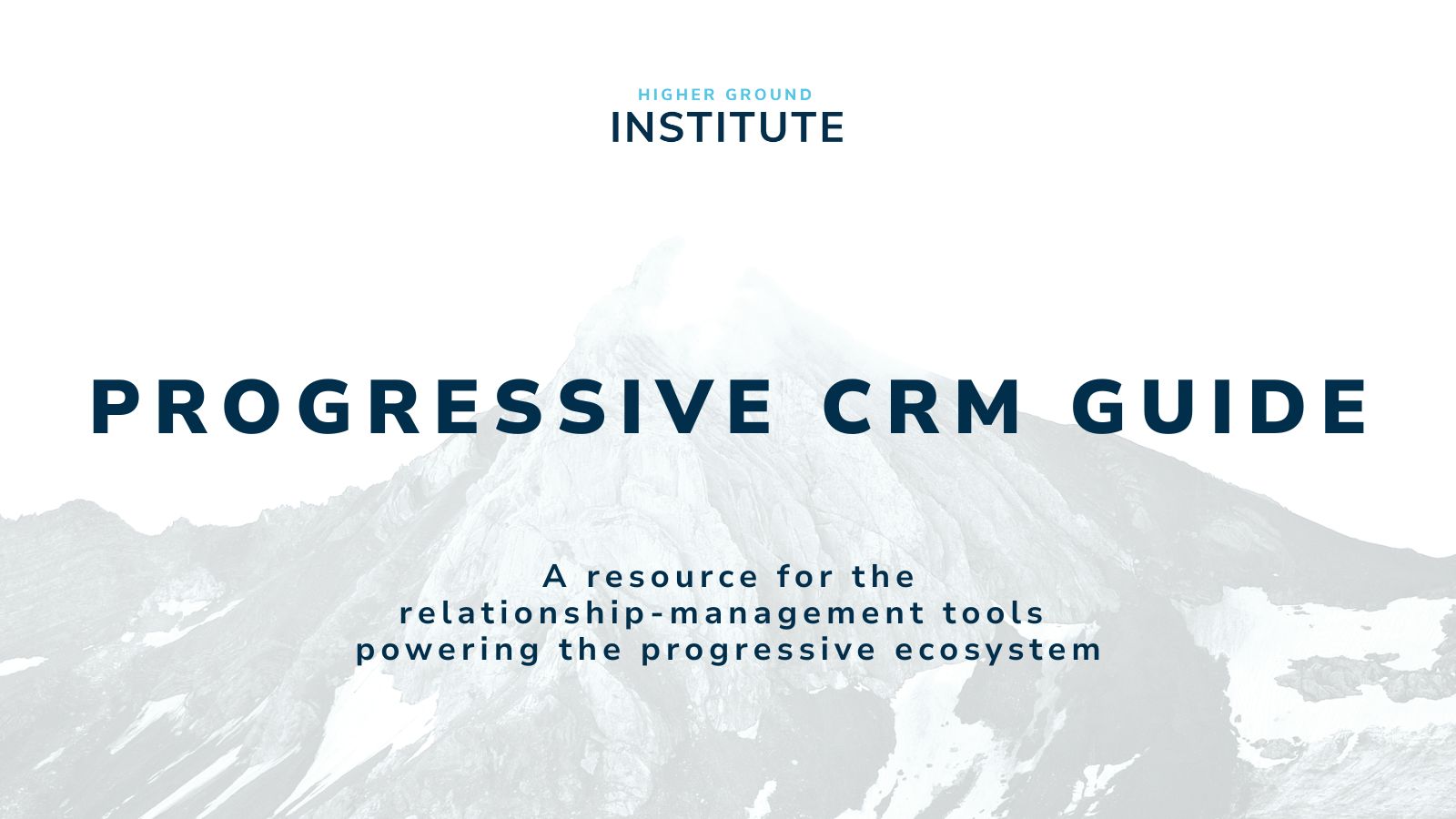Technology played a critical role in the 2024 election cycle, yet Democratic campaigns faced significant challenges, leading to tough losses in key races up and down the ballot. As campaigns increasingly rely on digital tools for voter outreach, research, fundraising, and mobilization, it is essential to reflect on what worked, what didn’t, and where improvements are needed ahead of 2026.
Every cycle, Higher Ground Labs releases the Election Tech Survey to assess how political technology is used and purchased by progressive campaigns and organizations. First launched in 2020 and now in its third cycle, this survey tracks trends in adoption, effectiveness, and persistent gaps in electoral tech. Our goal is to understand how campaigns and organizations are using technology, what barriers they face, and where investments can have the most impact.
For the 2024 survey, we gathered insights from respondents across campaign leadership, data and analytics teams, and key decision-makers within the progressive ecosystem. Their responses provide a view of how technology influenced this election cycle and what is needed to build a stronger, more tech-enabled movement moving forward.
With more in-depth analysis coming soon in our 2024 Political Tech Landscape Report, here’s a look at some of the key findings from this year’s survey:
Tech Spending Remains Low Across Campaigns and Organizations
Despite technology’s growing importance in modern campaigns, investment remains low. Across campaigns and organizations—including races up and down the ballot,as well as 501(c)(3)s, 501(c)(4)s, PACs, and state parties—an average of only 1–10% of budgets are allocated to technology, a number that has remained relatively unchanged across multiple election cycles. Compared to similar industries, political campaigns continue to underfund tech, limiting their ability to adopt and integrate the tools that could improve efficiency, effectiveness, and ultimately, electoral outcomes. Allocating a greater share of budgets to technology would allow campaigns to run more data-driven operations, enhance voter engagement, and improve coordination across teams—factors that can make the difference in competitive races.
 Campaign budgets for political technology captured by organization type and size.
Campaign budgets for political technology captured by organization type and size.
Encouragingly, more campaigns are recognizing the need to invest earlier, with a 15% increase since 2020 in those purchasing technology earlier in the cycle. While this shift is promising, it’s not enough. Many campaigns still delay key tech decisions, leading to rushed adoption that makes it harder to train staff and fully integrate tools. When technology is an afterthought rather than a core part of campaign strategy, its full potential is never realized. To stay competitive, campaigns must not only dedicate a larger share of their budgets to technology but also invest earlier in the cycle, ensuring their teams have the time and resources to implement tech in a way that drives real impact.
 Timeline of when campaigns engage tech vendors, tracked since our 2020 survey. While this data provides useful trends, direct comparisons between cycles should be made with caution due to differences in respondent size, election type (midterms vs. presidential), and external factors like the pandemic.
Timeline of when campaigns engage tech vendors, tracked since our 2020 survey. While this data provides useful trends, direct comparisons between cycles should be made with caution due to differences in respondent size, election type (midterms vs. presidential), and external factors like the pandemic.
AI in Campaigns: Adoption Is Growing, but Training and Strategy Lag Behind
While our political ecosystem has historically been cautious about adopting new technologies, AI is beginning to gain traction. Only 5% of survey respondents reported actively prohibiting AI use within their organizations, indicating a shift toward exploration and experimentation.
 One of three survey questions evaluating how campaigns and organizations integrated generative AI during this election cycle.
One of three survey questions evaluating how campaigns and organizations integrated generative AI during this election cycle.
However, adoption remains highly fragmented. Most campaigns reported using AI tools for content generation, donor communications, and event planning, but few are leveraging AI for more advanced applications such as predictive modeling, data analysis, or real-time voter engagement. In many cases, AI adoption was driven by individual staff experimentation rather than structured organizational implementation.
The Infrastructure Gap: Fragmentation Slows Campaigns Down
A major challenge facing political tech is the lack of seamless infrastructure to support data movement, integration, and cross-platform collaboration. Campaigns consistently report frustration with disjointed systems, which makes it difficult to aggregate, analyze, and act on data efficiently.
Even though more tools and data infrastructure are available than ever before, integration across platforms remains a challenge, limiting campaign capacity for real-time coordination and strategic decision-making. This fragmentation leads to duplicated work, poor data hygiene, and inefficiencies that hinder voter outreach and engagement efforts.
 Responses to: “Looking ahead, what needs tech advancement?” Our survey defined infrastructure as the long-term, scalable tech solutions that power ecosystem-wide data movement, access, and collaboration.
Responses to: “Looking ahead, what needs tech advancement?” Our survey defined infrastructure as the long-term, scalable tech solutions that power ecosystem-wide data movement, access, and collaboration.
By tracking this issue over three election cycles, we’ve seen that integration challenges have remained a top concern, reinforcing the need for more collaborative solutions, shared standards across political tech platforms, and expanded access to data infrastructure.
Bridging the Tech Support Gap: Tools Are Not Enough—Campaigns Need Guidance
Access to technology alone does not guarantee success—training, onboarding, and ongoing support are just as important. Many campaigns, especially down-ballot races and first-time candidates, report significant struggles with selecting, implementing, and maximizing political tech tools.
Beyond choosing the right tools, campaigns need clear guidance on budgeting, tool adoption timelines, and best practices for effective implementation. Without structured training and onboarding, campaigns risk underutilizing the tools they have invested in, leading to inefficiencies and missed opportunities.
To truly unlock the power of political technology, the progressive ecosystem must focus on making knowledge and training more accessible. This means creating playbooks, expanding tech support, and ensuring that digital strategies are integrated into campaign operations from day one.
 Response to the question, “What’s Your Biggest Challenge?”
Response to the question, “What’s Your Biggest Challenge?”
Looking Ahead: Strategic Priorities for the Next Election Cycle
The 2024 Election Tech Survey highlights a clear need for a more intentional, strategic approach to political technology. Key areas that demand attention include:
- Reframing tech spending as a force-multiplying investment rather than a minimal expense
- Building long-term infrastructure solutions that facilitate improved data integration and coordination
- Providing structured guidance and training to help campaigns adopt and use AI effectively
- Developing a knowledge-sharing ecosystem to ensure teams are equipped to maximize their tech investments
Thank you to everyone who contributed to this year’s survey—your insights are essential in shaping the future of political technology. We also extend our gratitude to our partners who helped distribute the survey: Stac Labs, Arena, Analyst Institute, Zinc Collective, CIL, DNC, ASDC, DMO, TMC, Bluebonnet, and Trestle, whose collaboration made this research possible.



